Kantabrien |
|
|
|
| Übersicht – Contents: | |
Kantabrien |
|
|
|
| Übersicht – Contents: | |
Flagge – Flag: |
|
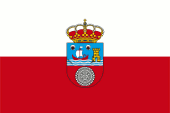 |
Flagge von Kantabrien |
| historische und andere Flaggen – historical and other Flags: | |
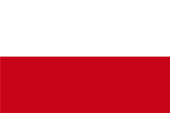 |
1845, 1982–1984, |
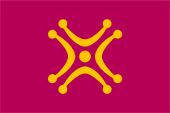 |
Lábaru, |
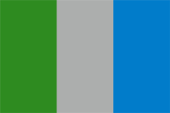 |
seit/since 1976, |
| Die heutige Flagge Kantabriens wurde am 30.12.1981 eingeführt. Sie zeigt zwei horizontale Streifen in Weiß und Rot und seit dem 22.12.1984 in der Mitte das Wappen Kantabriens. Das Wappen ist aus optischen Gründen leicht nach oben verschoben. Die Flagge wird häufig ohne Wappen dargestellt. Die Gestaltung der Flagge geht auf einen Entwurf von 1845 zurück. Eine weitere Flagge von großer regionaler Bedeutung ist das erst vor einigen Jahren populär gewordene "Lábaro Cántabro", das Kantabrische Labarum. Es geht auf das Aussehen der Fahnen der römischen Legionen zurück und greift die Verehrung auf, die die römischen Truppen ihren Feldzeichen entgegenbrachten. Das Motiv ist Symbolik, die von den kantabrischen Stelen aus vorrömischer Zeit inspiriert ist: vier Halbmonde, die sich zu zwei gegenüberstehen. Eine andere regionale Flagge ist die Flagge der ADIG (Asociación para la Defensa de los Intereses de Cantabria – Verein zur Verteidigung der Interessen Kantabriens), eine Flagge mit drei senkrechten Streifen in Grün, Grau und Hellblau. In den meisten autonomen Regionen Spaniens begann die neuere Flaggengeschichte bereits in den Jahren vor der Vergabe des Autonomiestatuts mit einer Flagge ohne Wappen, weil die Wappen oftmals noch gar nicht beschlossen waren. Immerhin hat sich meist durchgesetzt, dass die Flagge mit dem Wappen von den regionalen Behörden oder zu offiziellen Anlässen verwendet wird und die Flagge ohne Wappen quasi zu privaten, dekorativen Zwecken verwendet werden soll. | The
today’s flag of Cantabria was introduced on 30th of December in 1981. It
shows two horizontal stripes in white and red and since the 22nd of December
in 1984 the coat of arms of Cantabria in the middle. The coat of arms is a
little bit moved up because of optic reasons. The flag is frequently
reproduced without coat of arms. The design of the flag goes back to
a draft from 1845. Another flag of great regional importance is the "Lábaro Cántabro", the Cantabrian Labarum, which became popular only a few years ago. It goes back to the appearance of the flags of the Roman legions and picks up on the reverence that the Roman troops had for their insignia. The motif is symbolism inspired by the Cantabrian stelae from pre-Roman times: four crescents facing each other in twos. Another regional flag is the flag of the ADIG (Asociación para la Defensa de los Intereses de Cantabria - Association for the Defence of Cantabria's Interests), a flag with three vertical stripes in green, grey and light blue. In most autonomous regions of Spain, the more recent flag history already began in the years before the granting of the Statute of Autonomy with a flag without arms, because the arms had often not even been decided yet. After all, it has mostly become accepted that the flag with the coat of arms is used by the regional authorities or on official occasions and the flag without the coat of arms is to be used quasi for private, decorative purposes. |
| Quelle/Source: Wikipedia (ES), Wikipedia (EN), Volker Preuß | |
Wappen – Coat of Arms: |
|
 |
seit/since 1984, Wappen von Kantabrien – coat of arms of Cantabria, Quelle/Source, nach/by: Wikipedia (ES) |
| Das heutige Wappen Kantabriens wurde am 22.12.1984 eingeführt. Der Wappenschild ist geteilt und zeigt in seiner oberen Hälfte eine Szenerie aus dem Jahre 1248 als Kaufleute aus Kantabrien mit einem Schiff die Kettensperre des Hafens der maurischen Stadt Sevilla durchbrachen und somit großen Anteil bei der Befreiung der Stadt hatten. Die untere Hälfte des Schildes ist rot und zeigt eine silberne Scheibe mit geometrischen Mustern, eine Sonnendarstellung entnommen von den kantabrischen Stelen aus vorrömischer Zeit. Oberhalb des Wappenschildes erscheint eine Königskrone. | The
today’s coat of arms of Cantabria was introduced on 22nd of December in
1984. The blazon is separated and shows in its upper half a scenery from the
year 1248 as merchants from Canatbria broke though the chain-barrier of the
port of the moresque town Sevilla and played with this doing an important
roll in the liberation of this town. The lower half of the shield is red
and shows a silvery disc with geometric patterns, a representation of the
sun taken from the Cantabrian stelae of pre-Roman times. A royal crown
appears above the shield. |
| Quelle/Source: Wikipedia (ES), Volker Preuß | |
|
Die autonomen Regionen Spaniens – The autonomous Regions of Spain: Interaktive Landkarte - interactive map |
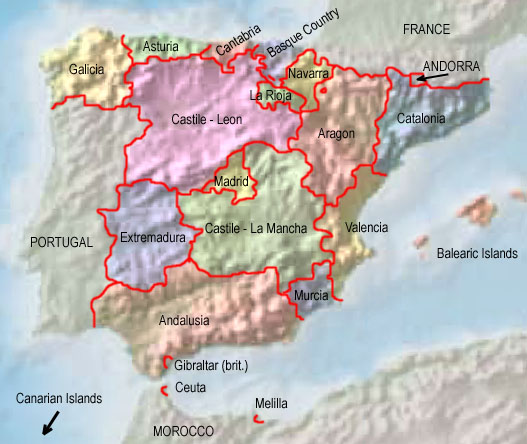 |
| Quelle/Source: Freeware, University of Texas Libraries, modyfied by: Volker Preuß |
|
Karte der historischen Königreiche auf der
Iberischen Halbinsel – Map of the historic Kingdoms on the Iberian Peninsula Interaktive Landkarte - interactive map |
| ca. 1220 |
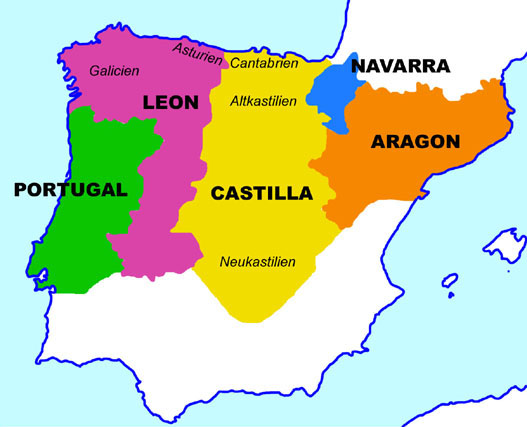 |
| Landkarte/map by: Volker Preuß |
| Zahlen und Fakten – Numbers and Facts: | |
|
|
|
|
|
|
|
|
|
|
|
|
|
|
|
Frühzeit
· Besiedlung des heutigen Kanatbriens durch das indogermanische Volk der
Kantabrer (lateinisch: Cantabri) Antike · Einwanderung der Iberer ca. 600 v.Chr. · Einwanderung von Kelten, die Kantabrer werden durch Vermischung zu Keltiberern 218–201 v.Chr. · Zweiter Punischer Krieg, das Römische Reich erwirbt die Besitzungen Karthagos in Iberien, Unterwerfung der ganzen Iberischen Halbinsel bis zum Jahre 19 v.Chr., in Kantabrien teilweise römische Besiedlung, teilweise Romanisierung ca. 400 n.Chr. · Völkerwanderung, Durchzug germanischer Alanen, Sweben und Westgoten, das heutige Kantabrien wird Teil des Westgotenreiches 711–714 · Vernichtung des Westgotenreichs durch von Nordafrika kommende Araber, die Westgoten ziehen sich nach Asturien und Kantabrien zurück wo sie sich mit den keltiberischen Kantabrern mischen, Bildung des westgotischen Herzogtums Kantabrien unter Herzog Peter, Errichtung der Hauptstadt Amaya, es gelingt den Arabern nicht Kantabrien zu erobern 739 · Wahl von Alfons I., Sohn von Herzog Peter von Kantabrien, zum Fürsten (König) von Asturien, Vereinigung von Asturien und Kantabrien ca. 800 · Alfons II. (König von Asturien) verteidigt Kantabrien in der Schlacht von Los Barrios de Luna gegen die Araber und schlägt sie vernichtend weitere Geschichtsdaten siehe Asturien 14.–15. Jahrhundert · die Häfen Kantabriens erlangen große Bedeutung für den Handel mit Wolle aus Kastilien 18.–19. Jahrhundert · die Häfen Kantabriens erlangen große Bedeutung für den Handel Spaniens mit seinen Kolonien in Amerika 1808–1813 · Kantabrien ist durch französische Truppen besetzt, Guerillakrieg gegen die Besatzer 1833 · die bis dato in Spanien bestehenden Teilkönigreiche und Regionen werden in Provinzen aufgeteilt, das Königreich Asturien in die Provinzen Oviedo und Santander (Kantabrien) 1936–1939 · Spanischer Bürgerkrieg, Kantabrien kämpft kurzzeitig (bis 1937) auf der Seite der sozialistischen Zentralregierung 11.01.1982 · Kantabrien erhält das Autonomiestatut innerhalb Spaniens (ehemalige Provinz Santander), Gründung der "Autonomen Gemeinschaft Kantabrien" |
|
early age
· settlement of the today's Cantabria by the Indo-European people of the
Cantabrians (Latin: Cantabri) antiquity · immigration of Iberians ca. 600 B.C. · immigration of Celts, the Cantabrians become to Celtiberians by mixing 218–201 B.C. · Second Punic War, the Roman Empire acquires the possessions of Carthago in Iberia, subjugation of whole Iberia until the year 19 B.C., in Cantabria partially Roman settlement, partial romanization ca. 400 A.D. · Great Transmigration (Migration Period), immigration of Alans, Suebs and Western Goth, the today’s Cantabria becomes a part of the Empire of the Western Goth 711–714 · annihilation of the Empire of the Western Goth by from northern Africa coming Arabs, the Western Goth retreat to Asturia and Cantabria where they start to mix with the Celtiberian Cantabrians, formation of the Western Goth Duchy of Cantabria under Duke Peter, erection of the capital Amaya, the Arabs are not successful in the conquest of Cantabria 739 · election of Alfons I., son of Duke Peter of Cantabria, to the Prince (King) of Asturia, unification of Asturia and Cantabria ca. 800 · Alfons II. (King of Asturia) defends Cantabria in the battle of Los Barrios de Luna against the Arabs and conquers them utterly further history data look Asturia 14th–15th century · the ports of Cantabria gain big importance for the trade with wool from Castile 18th–19th century · the ports of Cantabria gain big importance for the trade of Spain with its colonies in America 1808–1813 · is occupied by French troops, guerilla war against the occupators 1833 · the until that point in time in Spain existing partial kingdoms and regions become divided in provinces, the Kingdom of Asturia in the provinces of Oviedo and Santander (Cantabria) 1936–1939 · Spanish civil war, Cantabria struggles for a short time (until 1937) on the side of the socialistic central government 11th of January 1982 · Cantabria gets the statute of autonomy within Spain (former province of Santander), establishment of the "Autonomous Community of Cantabria" |
| Quelle/Source: Wikipedia (ES), World Statesmen, Volker Preuß |
| Der Name "Kantabrien" geht den indoeuropäischen Stamm der Kantabrer zurück, der hier in der Frühzeit und Antike siedelte. Der Name dieses Volkes schein baskischen Ursprungs zu sein, vielleicht hat es auch Baskisch gesprochen, die älteste Sprache Europas, denn das baskische Wort "kant" bedeutet "bei" und der Fluss Ebro heißt auf Baskisch "abre". Die Kantabrer waren die "beim Ebro" wohnenden. |
The name "Cantabria" comes from the Indo-European tribe of the Cantabrians,
who settled here in early and ancient times. The name of this people seems to be of Basque origin, perhaps they also spoke Basque, the oldest language in Europe, because the Basque word "kant" means "near" and the river Ebro is called "abre" in Basque. The Cantabrians were the people who lived "near the Ebro". |
| Quelle/Source: Handbuch der geographischen Namen | |